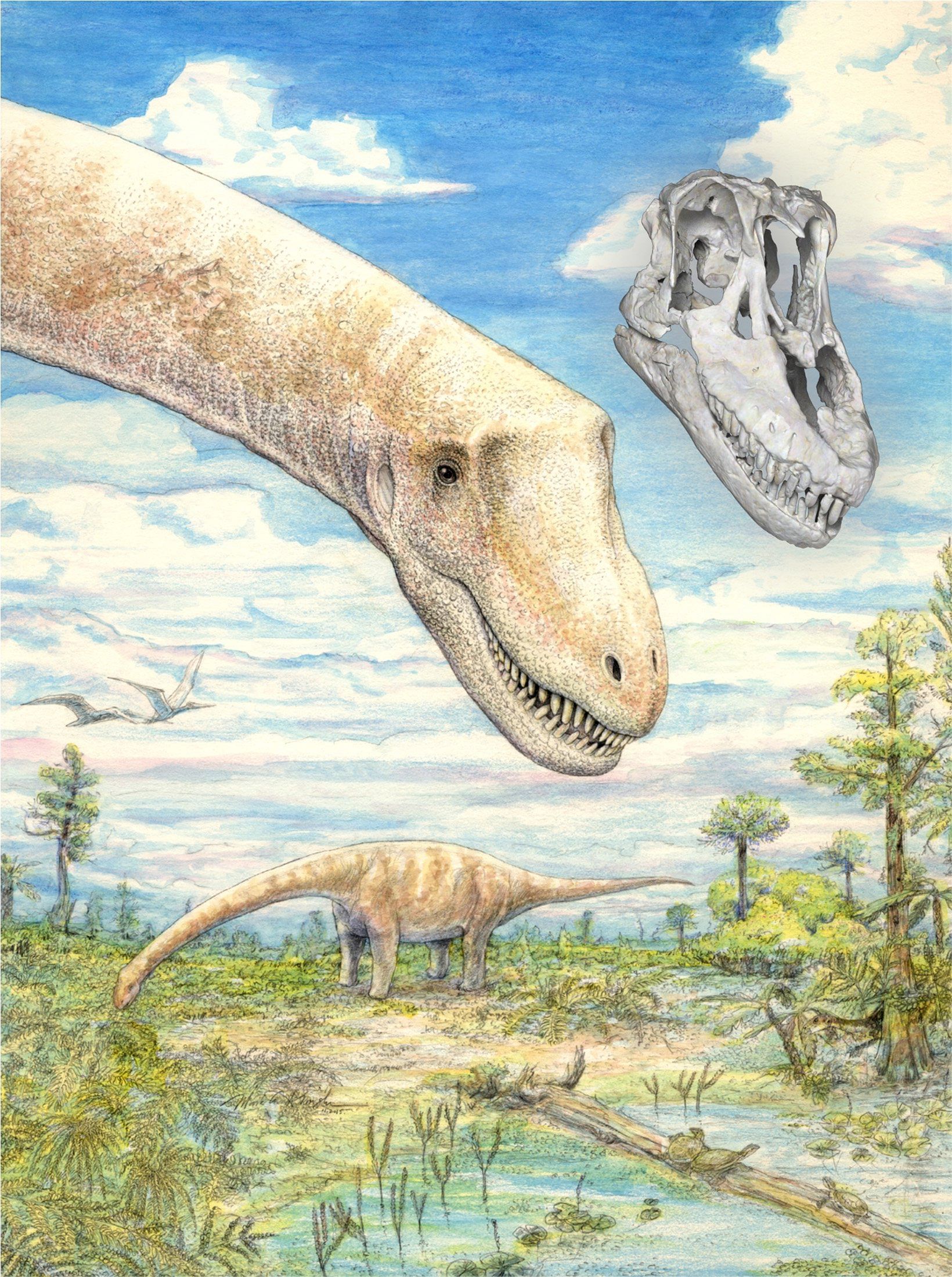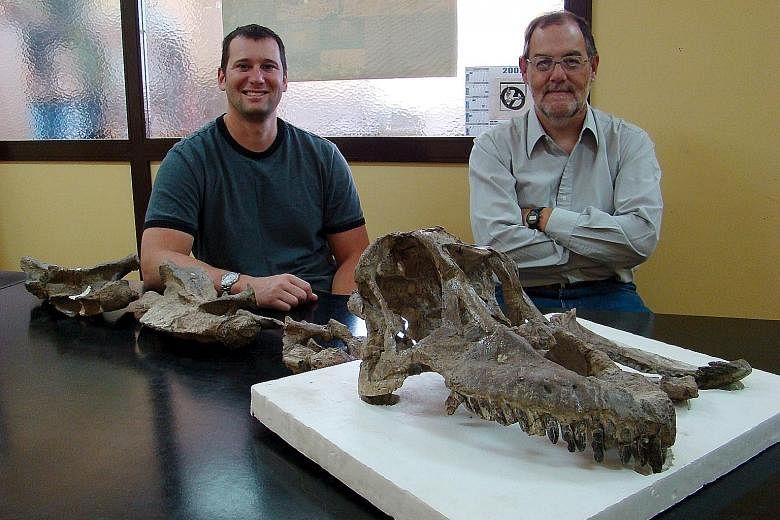A rare and finely preserved skull unearthed in Argentina belonged to a dinosaur with a drooping head, far bigger eyes and keener hearing than some of its more evolved relatives, providing new clues about this group of lumbering plant-eaters.
The discovery of the skull and part of the neck led palaeontologists to announce in the journal Plos One the naming of a new dinosaur, Sarmientosaurus musacchioi.
The fossil is from a dinosaur that was part of a group known as titanosaurs, and is considered modest in size, about 12m long and 9,000kg in weight, in contrast with some others in that grouping.
"About two elephants' worth," estimated Dr Matthew C. Lamanna, an assistant curator at the Carnegie Museum of Natural History in Pittsburgh in the US.
Titanosaurs were plant-eaters with long necks and long tails, and could be as small as a cow or as big as a house. While much is known about them, researchers still do not know much about their brains because so few skulls have been found.
"This group, to me, they're quite mysterious," Dr Lamanna said. "By combining data from these different discoveries, we're gradually building up a picture as to what the biology of these animals was like. In other words, what makes the largest land animals of all time tick?"

Meanwhile, in a paper published in the journal Science, a second group of palaeontologists described the remains of a baby titanosaur, noting its quick growth in a couple of months to the size of a large dog. Its bones had the same proportions of an adult, which suggests that young titanosaurs were quickly on their feet after hatching and fending for themselves.
For almost all known titanosaurs, palaeontologists have fossils of parts of the body, like leg bones that are taller than a person, but no pieces of the skull, which consisted of bones that were thinner, more delicate and less likely to fossilise.
For Sarmientosaurus, which lived about 95 million years ago, scientists have the opposite: almost all of the head, which was about half a metre long, and part of the neck, but nothing from the rest of the body.
Palaeontologists, including Dr Ruben D. F. Martinez of the National University of Patagonia in Argentina, found the skull in 1997. (Sarmientosaurus is named after the town of Sarmiento, close to where the skull was discovered; musacchioi honours Eduardo Musacchio, a palaeontologist who died in 2011.)
For a while, it was not clear what kind of dinosaur it was.
With CT scans, the scientists could study the skull in detail, including some defining characteristics seen in the few other titanosaur skulls that have been found. In other ways, Sarmientosaurus was unlike other titanosaurs, with a broad snout and fatter teeth. It also had very large eye sockets, suggesting better-than-average eyesight, and an inner ear structure that appears tuned to low-frequency sounds. "Maybe to track predators," said Professor Lawrence M. Witmer, a palaeontologist at Ohio University and another of the authors of the Plos One paper. "Maybe to track the movement of its own herd." Curiously, from the scattered skull data, the more evolved titanosaurs appeared to have worse eyesight and hearing, Prof Witmer said.
The orientation of the inner ear also suggests that Sarmientosaurus typically held its head pointing downwards at a 45-degree angle. The scientists infer that it foraged on plants near the ground.
"The head of titanosaurs is totally key to understanding them as living animals," Dr Lamanna said.
Sarmientosaurus' brain was the size of a plum or a lime. "It's pretty small," Prof Witmer said.
On the other hand, perhaps brains are overrated. Titanosaurs survived for tens of millions of years and lived on every continent, thriving in particular in the Southern Hemisphere. "The lime-size brain of Sarmientosaurus was adequate," Prof Witmer said.
In the Science paper, Professor Kristina A. Curry Rogers, a geology and biology expert at Macalester College in Minnesota, and her colleagues describe 17 bones that were excavated in Madagascar in 1993. Prof Curry Rogers came upon them in drawers at Stony Brook University in Long Island, where they had been misidentified as crocodiles.
Her doctoral thesis research had been describing a Madagascar titanosaur named Rapetosaurus - Rapeto is a mischievous giant in Madagascar folklore - and these bones looked like miniature versions of what she had worked with years earlier. "I just happened to be the right person to be looking at them," she said.
Titanosaur embryos had previously been found at a nesting site, but baby dinosaurs are rare. "This is surely the smallest out-of-the-egg sauropod," she said.
Closer study confirmed this was a young Rapetosaurus.
Slicing thin sections of the bones and looking at them under a microscope, the scientists could see lines that indicated how big the dinosaur was at hatching - about 3.4kg. When it died, 39 to 77 days later, it had grown to 36cm tall and 40kg, the scientists estimated.
Comparing the bones with fossils of other Rapetosauruses, the scientists found that baby Rapetosaurus looked like a miniature adult. That suggests that the baby dinosaurs were not being fed by the parents, but were already on their feet and foraging. The microscopic structures of the leg bones also indicated that they were already bearing weight, adding evidence to the argument.
With a robust skeleton, a baby Rapetosaurus might have been able to jump, trot and roll on the ground in ways that its parents would not have been able to.
The bone structure also hints at the baby's demise - starvation in a region prone to droughts.
Dr Kenneth J. Lacovara, a palaeontologist at Rowan University in New Jersey who was not involved in either study, said the research highlighted how much modern technology like CT scans have added to the study of dinosaurs.
"Those are great examples of palaeobiology," said Dr Lacovara, who discovered Dreadnoughtus, one of the leviathan titanosaurs.
"Now I think we're getting to the point where we're functioning more like biologists than geologists."
NEW YORK TIMES

